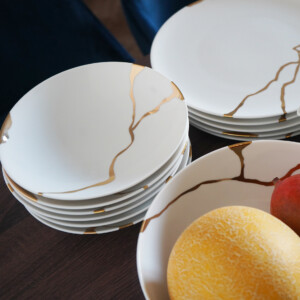If you are looking to purchase a new kitchen knife you have probably encountered two important knife types: Western and Japanese kitchen knives. In today’s article, we asked professional Chef Olivia Burt to talk to us about Western vs Japanese knives and her preferences.
In Chef Olivia’s words: What I love about Japanese knives is that their blades are extremely thin, more than western counterparts. This allows Japanese knives to stay much sharper for longer. I’m a big fan of the bevelling/ hammering. It stops things from sticking to the blade as much, something lacking on western knives. I also prefer the Japanese handles, it feels more comfortable in my hand. They fit much nicer and neater in my hand, making it (cutting) a much more enjoyable, comfortable experience.
As mentioned in the video above, Chef Olivia suggests getting just three Japanese knives: A chef’s knife (Gyuto or Santoku), a Nakiri (vegetable knife) and a Petty (paring knife). Read on to learn about these knives.
The Gyuto
If you’re looking to invest in one but a good quality knife, then you should be looking at a Japanese Gyuto knife. This type of knife is the equivalent of a traditional Western Chef’s knife. Gyuto is roughly translated as “cow sword” as it was initially used to cut meat and fish. However, it makes for an excellent all-purpose knife as they are very versatile and can cut through meat, vegetables and fruit.
The edge has a gentle curve toward the point, which makes it ideal for cutting tougher produce such as fruit and vegetables in a rocking motion. It is also tall enough to provide good surface contact for your knuckles when chopping. The blade’s profile allows for more contact with the chopping board, meaning less fatigue for the user.
Chef Olivia uses the Sakai Kyuba Gyuto for all the kind of kitchen jobs. Namely, “for meat, fish, vegetables, it is a true all rounder”.
The Santoku
Santoku knives are another type of Chef’s knives. Their name is Japanese for “three virtues”. These virtues refer to working with meat, fish and vegetables. You can use a Santoku in most recipes that call for knife work.
Some, especially women who usually have smaller hands and grips, consider Santoku to be more agile than Gyuto due to their size. They’re usually shorter than long chef knives less than 21cm/210mm, this Sakai Kyuba Santoku is 19cm/190mm and has wide, flat blades and fairly blunt or slightly rounded tips. This helps combat hand fatigue and compensates for the fact that you have to actually chop and not rock.
Chef Olivia Burt believes this is a great alternative for those who find the bigger sized chef’s knife (Gyuto) a bit scary.
The Nakiri
Japanese Nakiri knife is mostly used for cutting vegetables. It features a thin and wide blade and squared off tips. As it is designed for chopping veggies, the knife has a straight blade that can cut through long items (think eggplants, carrots) as well as make super thin slices out of cucumber, bitter gourd, tomatoes and the likes.
Thanks to their straight blade, Nakiri are ideal for julienne, brunoise allumette and other precision knife cuts for vegetables. Also a great tool for cutting into very hard skinned produce like pumpkins and squash.
According to Chef Olivia this is perfect for bigger vegetables. The width of the blade is perfect also for cutting onions. It is a great knife for beginners as the square end is safer, there is no pointy end/ spike to stab yourself with. “This is my main vegetable prep knife in the kitchen”
The Petty
Sometimes called a utility knife, the Petty is a smaller version of a Chef’s knife but is bigger than a paring knife. The Petty fits in small places that require more dexterity than bigger chefs knives while handling bigger jobs than a paring knife can take care of.
Its incomparable sharpness is used for smaller precision tasks such as peeling, trimming, and slicing small fruits and vegetables as well as for handling bigger tasks as a small Chef’s knife. You can use it in your hand for things you would normally use a paring knife and use it on your board just as easily.
The smaller size and relatively narrow blade make the knife very nimble and controllable. It is an ideal alternative to Gyuto for people with smaller hands.
Chef Olivia prefers using this knife for little prep jobs veggies, smaller greener vegetables and meat as well. She feels it is very tough and small, easy for precision tasks.


























